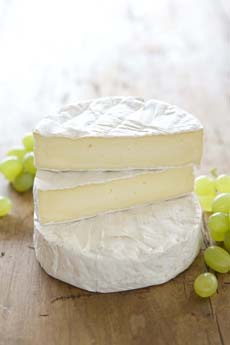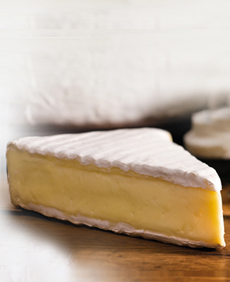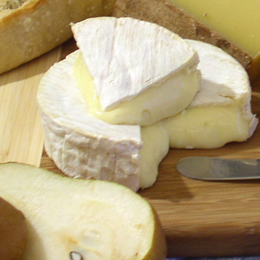
 You can tell after you cut into it, of course. But how do you know if the Brie or Camembert is ripe before you cut it? Photo courtesy Whole Foods Market. You can tell after you cut into it, of course. But how do you know if the Brie or Camembert is ripe before you cut it? Photo courtesy Whole Foods Market.
|
STEPHANIE ZONIS focuses on good foods and the people who produce them.
|
|
May 2007
Last Updated March 2012
|
 |
How To Pick A Ripe Brie Or Camembert
Page 3: Ripeness Is Key
This is Page 3 of a four-page article on Brie and Camembert. Click on the black links below to visit other pages.
Selecting A Ripe Brie Or Camembert
Now that you have some background about these great cheeses, let’s discuss selection. Supposing you’re lucky enough to have a good cheese retailer nearby: How do you tell a ripe Brie or Camembert from one that’s under- or overripe? Gilles of Artisanal Premium Cheese explains that this process is “not for the novice,” although there are “very subtle signs.”
- Pristine White Rind: Too Young. Gilles declares that a very young Brie or Camembert will have a rind that is “pristinely white.” Such cheeses are liable to be chalky-textured and solid inside—in a word, underripe. This is not what you want. You are looking for that “pristinely white” rind to become mottled with a coloring that is variously described as reddish, brownish, or yellowish.
- Downy Rind: Better. The Camembert Web Pages states that the rind should look like “a thin white down” and may be covered with very small red dots. But Gilles urges caution in this visual examination, as appearance depends on origin. He says that an industrially-produced Brie or Camembert might purposely have a perfectly white rind at maturation, because such a rind would appeal to the average consumer who has not been educated about cheese. Mottled rinds could well be unappealing to such a consumer, so factory Brie or Camembert rinds may simply not acquire such coloration.
|

The paste of this factory Brie shows a very slight bulge of ripeness. Compare it to the ripe, runny cheese in the photo below. Photo courtesy DCI. |
- Mottled Rind: Not Great. Steven Jenkins suggests a sneak peek at the cheese by slightly lifting its paper wrapping. If the rind is “ugly,” the Camembert is past its prime. And overripe Brie, he maintains, will be inordinately runny, with the rind “completely falling away from the oozing cheese.”
- Paste. The interior, or paste, of both Brie and Camembert should be straw-colored. While Brie and Camembert are softer cheeses, Jenkins notes that many Americans have the wrong idea about the texture of the paste when the cheeses are ripe. Real Brie, he insists, should not have a runny interior when it is perfectly ripe. At most, you’re looking for an interior that should “bulge” or flow minimally; if the interior is truly runny, the Brie is probably overripe. Factory-produced, pasteurized-milk Brie, the only kind most people in the US know, is not generally acknowledged to be ripe until the interiors are runny, however. The lesson here seems to be “know what you’re buying.”
- Smell. There are also smell and touch tests. Gilles tells me that a typical trick in France for Camembert is to turn the wooden box in which it comes upside down and remove the bottom. Take a sniff of the cheese. If it smells good, that’s a promising sign. If there is even the slightest odor of ammonia, don’t buy it: The cheese is overripe.
- Touch: For a touch test, Jenkins has prospective Brie or Camembert buyers make a loose fist. Now, gently press the fleshy area between index finger and thumb, which he says “should yield to the touch like bread dough.” This, he asserts, is the feel of a perfectly ripe cheese of this type.
|
|

A ripe, runny Camembert—but not overly runny. Some people like a very runny cheese; others, don’t. Cheese available from iGourmet.com. |
Continue To Page 4: Enjoying Your Cheese
Go To The Article Index Above
Lifestyle Direct, Inc. All rights reserved. Images are the copyright of their respective owners.

|




 You can tell after you cut into it, of course. But how do you know if the Brie or Camembert is ripe before you cut it? Photo courtesy Whole Foods Market.
You can tell after you cut into it, of course. But how do you know if the Brie or Camembert is ripe before you cut it? Photo courtesy Whole Foods Market. 
